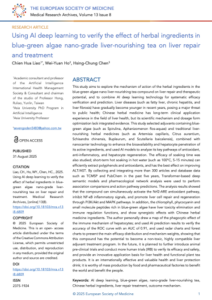Home > Medical Research Archives > Theme Issues > Challenges and Opportunities in Alzheimer’s Disease
Theme Issue:
Challenges and Opportunities in Alzheimer's Disease
Alzheimer’s disease remains one of the most pressing neurological challenges of our time, with profound implications for patients, families, and healthcare systems worldwide. This theme issue highlights the evolving landscape of Alzheimer’s research and care, bringing together insights that span from early diagnostic innovations to emerging therapeutic strategies.
Contributors explore contemporary challenges such as the complexity of disease pathophysiology, the limitations of current pharmacological options, and the need for more effective biomarkers. At the same time, opportunities are illuminated through advances in neuroimaging, precision medicine, digital health interventions, and integrative models of patient-centered care. Ethical and social considerations—including equitable access to new treatments and the importance of caregiver support—are also emphasized.
Collectively, these perspectives underscore the urgent need to bridge scientific discovery with clinical application, offering a comprehensive view of the challenges and possibilities shaping the future of Alzheimer’s disease management and research.
This theme issue was organized in collaboration with the Neurodegenerative Disease Committee.
Contents
Research Article
Study of the Impact of Transcatheter Intracerebral Laser Photobiomodulation Therapy Treatment on Patients with Alzheimer's Disease and Binswanger's Disease
Transcatheter Intracerebral Laser Photobiomodulation Therapy (PBMT) is an effective, physiologically based method of stimulating cerebral angiogenesis and neurogenesis for Alzheimer’s Disease and Binswanger’s Disease patients. Due to complex laser exposure, patients show cerebral collateral and capillary revascularization, tissue metabolism improvement and cerebral regenerative processes development. Clinically, this leads to stable dementia level decrease, cognitive functions restoration and improvement in patients’ quality of life. The resulting clinical effect lasts for many years.
By Ivan V. Maksimovich - Clinic of Cardiovascular Diseases named after Most Holy John Tobolsky, Building 2, Block 15, 6th Lazenki Str., 119619 Moscow, Russia.
Research Article
Are the Newest Anti-Alzheimer’s Medicines Being Evaluated Under Outdated Pricing Paradigms?
The 2021 approval of aducanumab in the United States, was not followed by approvals in Europe, Canada, Australia or elsewhere; nonetheless, the initial pricing of $56,00.00/year created a firestorm of controversy. The 2023 Food and Drug Administration approval of lecanemab has been followed by approvals in Japan and China. The current (2024) costs are $26,500 in USA, $20,438 (National Health Insurance) in Japan and $28,180 (private market) in China. In Europe, a health technology assessment will drive coverage decisions and set single-payer prices for each health system for lecanemab and subsequently approved new treatments. For comparison, 2024 average pricing for the top five selling drugs for cancer [$198,273], arthritis [$83,666], hepatitis C [$75,118] and multiple sclerosis [$86,765] far exceed lecanemab’s annual cost. Could there be an anti-brain-health bias?
By Charles S. Wilcox, Ph.D., M.P.A., M.B.A. - Praxis Research Consulting, 1400 Quail Street, Suite #285, Newport Beach, California 92660 (USA); Alzheimer’s Association (Orange County); Alzheimer’s Impact Movement.
Research Article
Effect of Age, Cognitive Impairment Severity, and Duration of Disease on Efficacy of Masupirdine in Moderate Alzheimer's Disease Patients: A Post Hoc Analysis of a Phase-2 Randomized Placebo Controlled Study Results
Considering the linear relationship between age and cognitive decline, masupirdine effects across the subgroups could be attributed to “slowing of cognitive decline”. The study provides important findings for design of future clinical trials. Further research is warranted to confirm the potential beneficial effects of masupirdine on cognition in AD patients.
By Ramakrishna Nirogi, Ph.D., Vijay Benade, Ramkumar ., Subramanian ., Satish Jetta, Anil Shinde, Vinod Kumar Goyal, Santosh Kumar Pandey, Pradeep Jayarajan, and Venkat Jasti - Suven Life Sciences Limited, Serene Chambers, Road-5, Avenue-7, Banjara Hills, Hyderabad, Telangana - 500034, India.
Research Article
Beyond the Amyloid Hypothesis: Proteolytic Dysfunction in Familial Alzheimer's Disease
For over 30 years, the amyloid hypothesis of Alzheimer’s disease has dominated this field of biomedical investigation. The hypothesis posits that aggregation of the amyloid β-peptide (Aβ) in the brain triggers a cascade of events that ultimately lead to neurodegeneration and cognitive decline. Early genetic and biochemical evidence supported a critical role of Aβ, particularly the 42-residue form Aβ42: Dominant missense mutations in the substrate (amyloid precursor protein, APP) and enzyme (γ-secretase) that produce Aβ cause early-onset familial Alzheimer’s disease (FAD). Nevertheless, serious gaps remain in understanding pathogenic pathways, and despite intense efforts over many years, effective agents for Alzheimer’s disease have been elusive. Here I discuss recent efforts to elucidate precisely how FAD mutations alter the complex proteolytic processing of APP substrate by γ-secretase, with results suggesting pathogenic triggers other than Aβ42.
Michael S. Wolfe - Department of Medicinal Chemistry, University of Kansas, Lawrence, Kansas 66045 USA.
Research Article
Long-Term Inhalation of Hydrogen Gas for Patients with Advanced Alzheimer's Disease: A Case Report Showing Improvement in Fecal Incontinence
Molecular hydrogen (H2) has emerged as a therapeutic medical gas that exerts multiple functions. H2 inhalation has been approved as safe, and some clinical studies showed that it effectively improved conditions of patients with a variety of disorders such as stroke, heart infarction, chronic obstructive pulmonary disease, cancer, and COVID-19. Urinary and fecal incontinences are unavoidable symptoms of advanced Alzheimer’s disease (AD) dementia. In particular, fecal incontinence increases the level of confusion for patients and caretakers suffer from increased workloads.
Hirohisa Ono, Yoji Nishijima, Masaki Sakamoto, Soitirou Kitamura, Yuitiou Naitoh, Keiko Suzuki, Norio Fujii, Ryouta Kikura, and Shigeo Ohta - Department of Neurosurgery and Neurology, Nishijima Hospital, Ohoka, 2835-7, Numazu- city, Shizuoka-ken 410-0022, JapanDepartment of Neurology Medicine, Juntendo University Graduate School of Medicine, 2-1-1 Hongo, Bunkyo-ku, Tokyo 113-8421, Japan
Research Article
Transcatheter Intracerebral Laser Photobiomodulation Therapy Reduces Dementia and Cognitive Impairment in Patients with Various Stages of Alzheimer's disease
Transcatheter Intracerebral Laser Photobiomodulation Therapy (PBMT) is an effective, physiologically based method of stimulating cerebral angiogenesis and neurogenesis. As a result of such a complex impact, patients with various AD stages have cerebral capillary collateral revascularization, their tissue metabolism improves, and regenerative processes develop in the cerebral tissue. Tissue regeneration leads to an increase in the volume of the temporal and frontoparietal sections. Clinically, this leads to a stable decrease in dementia level, cognitive functions restoration, and improved quality of patients’ life. The resulting clinical effect lasts for many years.
Ivan V. Maksimovich - Clinic of Cardiovascular Diseases Named after Most Holy John Tobolsky
Research Article
Identifying Alzheimer's Disease Dementia Levels Using Machine Learning Methods
Dementia, a prevalent neurodegenerative condition, is a significant aspect of Alzheimer’s disease (AD), causing progressive impairment in daily functioning. Accurate and timely classification of AD stages is crucial for effective management. Machine learning and deep learning models have shown promise in this domain. In this study, we proposed an approach that utilizes support vector machine (SVM), random forest (RF), and convolutional neural network (CNN) algorithms to classify the four stages of dementia. We augmented these algorithms with watershed segmentation to extract meaningful features from MRI images. Notably, our findings demonstrate that SVM with watershed features achieves an impressive accuracy of 96.25%, outperforming other classification methods. The evaluation of our method was performed using the Alzheimer’s Disease Neuroimaging Initiative (ADNI) dataset, and the inclusion of watershed segmentation was found to significantly enhance the performance of the models. This study highlights the potential of incorporating watershed segmentation into machine learning-based AD classification systems, offering a promising avenue for accurate diagnosis and treatment planning.
Md Gulzar Hussain and Ye Shiren - School of Computer Science and Artificial Intelligence, Changzhou University, Changzhou, Jiangsu, China
Researching neurodegenerative disease?
We would like to hear from you. Write to us at [email protected]


